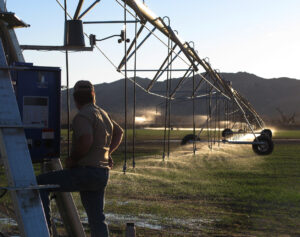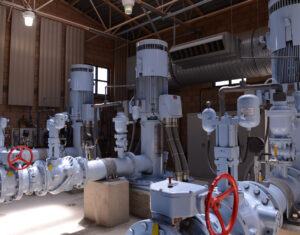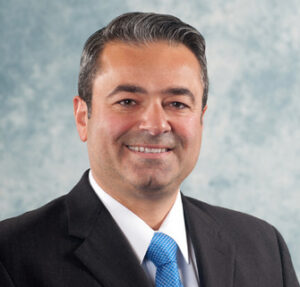How has California’s Eastern Municipal Water District (EMWD) decreased its dependence on imported water during a period when the local population nearly doubled? By taking water use efficiency seriously and making smart investments in local resources, including recycled water and desalination plants. In this interview, new General Manager Joe Mouawad talks about how his forward-thinking agency is planning for a drier future.
Municipal Water Leader: Please discuss your background and how you came to be in your current position.
Joe Mouawad: For the past 30 years, I have been a part of the water industry, and in 2006, I joined EMWD as its director of engineering. Since then, I’ve had the privilege to take on additional responsibilities at the district, including serving in various leadership roles. Most recently, I served as assistant general manager, overseeing the planning, engineering, and construction branch. In May 2021, I was fortunate enough to be selected as EMWD’s general manager.

Municipal Water Leader: How have your past positions at the district prepared you for the role of general manager?
Joe Mouawad: Since starting at EMWD, I have been actively involved in many of the efforts that have propelled the district to become nationally recognized as a progressive agency. This included being responsible for overseeing the district’s capital improvement program, which typically invests $100 million a year in infrastructure to expand our water, wastewater, and recycled water systems. EMWD’s board of directors has long made it a strategic priority to become a national leader in water reuse, to expand our investments in local groundwater supplies, and to secure record-setting grant funding to reduce the financial burden on our customers. My experience in helping implement those strategic priorities provided the foundation for me to serve as general manager.
Municipal Water Leader: Please discuss EMWD’s history and current services.
Joe Mouawad: EMWD was established in 1950, organized under the Municipal Water District Act for the purposes of importing Colorado River water to our service area to augment local water supplies. We just celebrated our 71st anniversary. Today, we receive approximately half our water supply from the Metropolitan Water District of Southern California (MWD), water ultimately sourced from the Colorado River Aqueduct and the State Water Project. EMWD has been fortunate in having a series of forward-thinking board members and managers. This has resulted in investments in a diverse water supply portfolio that includes local groundwater supplies, recycled water, and desalination efforts. EMWD is currently the sixth-largest public water utility in the state of California. We serve more than 156,000 water connections, approximately 246,000 sewer connections, and more than 600 recycled water connections. EMWD is committed to delivering value to our diverse customers and to the communities we serve by providing safe, reliable, economical, and environmentally sustainable water, wastewater, and recycled water services.
Municipal Water Leader: Would you talk about your service area in terms of its population, land use, and growth?
Joe Mouawad: We serve the western Riverside County area, which spans 558 square miles and represents more than a million residents. While most of our customers are residential, we also serve commercial and agricultural customers and provide wholesale service to the area’s water purveyors.
Our board of directors has always had a strategic vision. EMWD staff are implementing that vision through planning efforts not only to build the necessary infrastructure for the future, but to look for innovative ways to be more efficient with the resources we have. For example, in 2009, we adopted a water budget– based tiered rate system, which led EMWD customers to embrace a culture of efficient water use habits and reduced per capita use by approximately 41 percent over the past two decades. Those numbers have continued to get even better as we face another historic drought. Over the last 20 years, the population in our service area has increased 93 percent, but our overall reliance on imported supplies has decreased by 3 percent as our use of recycled water has dramatically increased. We’ve made significant investments in local resources to ensure that we’re not increasingly reliant on imported supplies to meet the demands of our communities.

EMWD staff conduct extensive planning work not only to anticipate overall growth, but also to know where growth is going to occur within our service area. We work in collaboration with the development community and land use agencies to ensure that our infrastructure can accommodate the additional demands from increases in population.
Municipal Water Leader: Would you discuss the makeup of your water supply and how vulnerable each source is to drought?
Joe Mouawad: Due to the investments EMWD has made over the last 20 years, 50 percent of our water comes from the Colorado River Aqueduct and the State Water Project, and the remaining 50 percent comes from local resources, such as groundwater. EMWD started with the primary purpose of importing water to augment local supplies for our growing region. Our forward-thinking board and leadership understood early on that the best way to provide reliable supplies to a growing service area was through diversification. This is why we continue to invest in maximizing local groundwater supplies through desalination; recycled water projects; and robust water use efficiency programs, including our water budget–based tiered rates. While imported supplies can be the most vulnerable to drought and other factors, such as regulatory restrictions, all water supplies are vulnerable and need to be managed well.
Recycled water is a key component of our local resources, and we have consistently used more than 95 percent of the recycled water we produce. It is used primarily to meet the demands of agriculture in our service area as well as the irrigation demands of parks, schools, and environmental habitat. We also have desalination facilities, where we treat brackish local groundwater to make potable water for the communities we serve. These sources, in addition to EMWD’s local groundwater wells, are all integral parts of EMWD’s diverse water supply portfolio.
Municipal Water Leader: Would you explain your water budget–based tiered rates?
Joe Mouawad: EMWD provides a unique water budget for every customer, based on individual needs and circumstances. One portion of the total water budget is based on the number of occupants in the house, and the other portion is based on the size of a customer’s irrigated landscape and the specific weather conditions. Tiered rates are proportioned based on cost of supply and applied as water is used by the customer. For example, our tier 1 rate aligns with the lowest-cost supply, which is local groundwater, and every customer’s budget is allocated 20 percent to this lowest rate. The second tier equates to the remaining budgeted supply. If customers use more water than is allocated for their water budget, they pay a higher rate, and if they use more than 50 percent more than their water budget, they are charged the highest rate. It’s important to note that over the past 3 years, an average of 80 percent of our customers have stayed within their budget. We’re proud of the fact that our customers have reacted to our call to be water efficient and use water wisely. That track record speaks volumes about the responsiveness and the attitudes of our customers.
Municipal Water Leader: Does the district expect to be affected by the tier 1 shortage on the Colorado River?

Joe Mouawad: EMWD is a member of MWD. We anticipate that by the end of next year, if conditions do not improve, MWD and the State of California will have to contribute water as part of the Drought Contingency Plan for the Colorado River. We are already planning for that possibility. For that reason, we have continued to ask our customers to voluntarily consider reducing their outdoor water use by as much as 25 percent through a messaging campaign for all our customers. We are also looking at the potential challenges ahead of us with the State Water Project. However, EMWD’s significant investments in local resources reduces its vulnerability during drought cycles.
Municipal Water Leader: Beside diversifying water supply and encouraging conservation among your users, in what other ways is the district addressing ongoing and cyclical drought conditions?
Joe Mouawad: Every 5 years, we complete an urban water management plan to align our efforts with those of the cities and unincorporated areas, to meet the needs of the community, and to plan infrastructure for the growing population in our service area. We calibrate our capital improvement plan annually to make certain our future infrastructure needs for water, wastewater, and recycled water services are designed and constructed to complement growth in the service area.
Whether it’s an expansion of a treatment plant, addition of a desalination facility, or additional pipelines in the ground to connect customers to our services, EMWD has always tried to be prepared. For example, we are currently building our third desalination plant. That facility, which is scheduled to come online in the first quarter of 2022, will add another 5.4 million gallons per day of potable supply. Also, we are currently under construction on our North Perris groundwater program, through which we’re going to be able to extract local groundwater and treat contaminants that have historically existed in that aquifer, ultimately producing about 5,000 acre-feet of potable water per year to serve the local community. We continue to make investments in local resources, knowing that our imported supply may be restricted going forward due to drought conditions.
Municipal Water Leader: Has the district continued to expand its renewable energy portfolio?
Joe Mouawad: EMWD has always focused on using all our available resources to generate clean energy. Right now, we are on our third phase of solar power generation expansion. We previously installed 5.5 megawatts of solar facilities at our headquarters and at our treatment facilities. The third phase is coming online soon and will bring an additional 16 megawatts of solar generation. At that point, we will be producing approximately 50 percent of the energy used for EMWD’s treatment facilities, pump stations, and the total energy needs of the district.
EMWD has been able to expand its solar generation facilities through grant funding and power purchase agreements. We’ve been proactive when it comes to securing state and local funding to advance solar and other clean energy initiatives. We also use our digester gas reclamation facilities to capture a byproduct of the treatment system to generate energy through fuel cells and other technologies, including microturbines.
Municipal Water Leader: Who are the district’s main partners and stakeholders?
Joe Mouawad: We have strong partnerships and collaborations within our community; throughout the water, wastewater, and recycled water industry; and with our local, state, and federal legislators. Our board of directors has made it a priority to foster partnerships with stakeholders and other agencies whenever possible to benefit the communities we serve. One example of this collaboration is the Santa Ana River Conservation and Conjunctive Use Program. It is a first-of-its-kind regional groundwater banking program. It involves EMWD, the Inland Empire Utilities Agency, the Municipal Water District of Orange County, the Orange County Water District, the San Bernardino Valley Municipal Water District, the Western Municipal Water District, and MWD. The program allows us to work collectively to import additional water into the region and store that water in various spaces throughout the Inland Empire. We’re proud of those types of local and regional collaborations and partnerships, as we believe they will form the path forward by which we can provide a more secure water future for our communities.
Municipal Water Leader: How do you intend to continue to position EMWD as an industry leader?
Joe Mouawad: We intend to remain an industry leader by continuing the strategic direction set by the EMWD board of directors to find innovative and collaborative solutions to maximize our resources and provide the most efficient and economical services possible to our customers. We are currently updating our triennial strategic plan, which anticipates changes and challenges to develop initiatives and programs to address an ever-evolving industry. Our approach is to be consistently proactive rather than reactive on industry issues.
Municipal Water Leader: What is your vision for the future of the district?
Joe Mouawad: EMWD is a standards-driven organization that continues to develop and implement multifaceted approaches to ensure superior service through advances in technology and through solid financial planning to provide our customers with exceptional value. In addition, our planning and continuous improvement practices are part of EMWD’s long-term plan to meet the needs of a growing and evolving customer base. My vision is to continue those practices while also sharing EMWD’s expertise and knowledge with other industry leaders and representatives to work together to better serve all our communities.
Joe Mouawad is the general manager of the Eastern Municipal Water District. For more information, please visit www.emwd.org or contact EMWD’s public and governmental affairs department at publicandgovtaffairs@emwd.org or (951) 928‑3777, ext. 4340.

